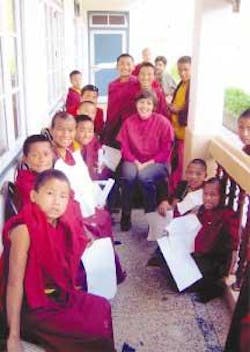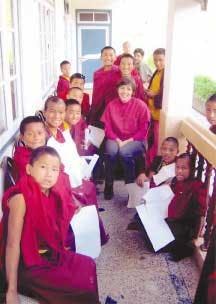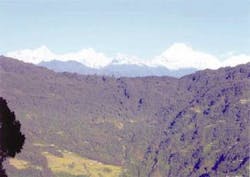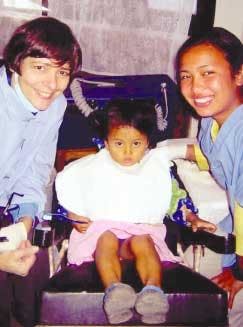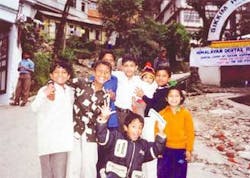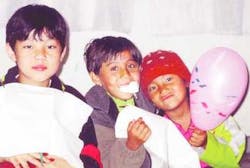Caring for children on the rooftop of the world
U.S. dental volunteers introduce Asia’s poorest children to oral health. This is Dr. Nancy Turck’s story.
Dr. Nancy Turck is packing for her next trip overseas, this time to Vietnam. She joins a growing group of dental professionals who share their skills in bringing dental care to children in charity schools, orphanages, and remote villages in Nepal, India, and Vietnam. For these impoverished children, dental care would be physically and financially inaccessible otherwise.
This year, Dr. Turck leads a group of dentists, hygienists, and nonmedical volunteers to join Vietnamese dentists in a village clinic located 30 minutes outside of Danang. The clinic set up in the local school will provide treatment and preventive care to 500 children.
Volunteers use portable dental units, field-adapted Cavitrons, and pressure-cooker sterilizers. While dentists and hygienists treat patients, local teachers and parents pitch in as translators and give individual instructions on oral health and hygiene.
Dr. Turck is a volunteer with the Himalayan Dental Relief Project, a Denver-based charity dedicated to bringing care to children in schools, orphanages, and remote villages in Nepal and surrounding countries. Closer to home, Dr. Turck practices dentistry at the Seattle Indian Health Board, a clinic for underserved populations. She earned her dental degree from Northwestern University before practicing in the Pacific Northwest. Having worked in the United States in community health, she was eager to extend her work to a world setting.
Dr. Turck began her adventure with a Himalayan Dental Relief trip during the fall of 2003 in Sikkim. We first met Dr. Turck - bleary-eyed from flying halfway around the world - when she arrived at the Sikkim airport with a face lit by a smile we came to love and an unflagging enthusiasm for adventure. From the airport, she traveled three hours to Gangtok, the capital city of Sikkim and a magical land nestled at the foot of the Himalayas. Volunteers set up the mobile clinic in the shadow of Kunchenjunga, the world’s third-tallest peak.
Our base in Gangtok, a local orphanage called the Happiness Home, provides a home to young girls who are orphaned or otherwise financially unsupported. The Colorado-based dZi Foundation operates the home and served as generous hosts. We transformed the living room into a densely packed dental clinic that operated at full force for seven days.
Each day, Dr. Turck and the volunteers arrived to find the courtyard abuzz with children. For her and the others, the morning ritual motivated them for each long workday. Dr. Turck’s experience was heightened by the rapport she built with Sharmila, a 16-year-old orphan brought in to help at the clinic by the dZi Foundation. Working at Dr. Turck’s side, Sharmila helped children understand the complex procedures and quietly assured them. She and Dr. Turck blended their cultures and generations, resulting in enriched experiences for themselves and those of their patients.
Despite the long days, Dr. Turck relished the work.
“I am honored to be so immediately involved in the lives of these families and this culture; I am having the time of my life,” she said. “The children are great patients, even though they have never seen a dentist. The clinic is an amazing, positive experience. I love the way the children excitedly peek in the windows. They wait their turns with friends and are ready with wide-open mouths from the minute their names are called. I am in awe of these children who comply without a murmur and leave with a quiet thank you. I am grateful to have helped these children in Sikkim. I feel like I’m the one receiving the benefits of this clinic just by being involved with these kids.”
One aspect of the clinic that surprised our dental volunteers was the widespread presence of caries, even in the small children. The incidence is much higher than previously encountered in other parts of Asia. Unlike their parents who grew up without sweets and chocolates, this generation loves sweets, and their local availability is reflected in the states of their teeth.
Dr. Turck was particularly impressed by the way the volunteers were able to work with a local dentist, teachers, and even the local press to respond with a heightened educational campaign. Small groups of volunteers and teachers held impromptu assemblies at nearby schools where they handed out toothbrushes, conveyed the damaging effects of sugar, and demonstrated oral hygiene instruction.
Children recited “brush two times a day” and “brush for two minutes” as they brushed and asked questions. Newspapers and a radio station interviewed dentists and published detailed articles about dental care and its effects.
After seven days, the clinic ended amid heartfelt goodbyes and promises to return. From there, Dr. Turck and the group traveled several hours to a remote village and monastery situated on the steep, lush hillsides of Sikkim. There we set up camp for four days, waking to the chants of Buddhist monks in the nearby monastery and working with local children and monks from the monastery school.
Work resumed in a quickly assembled clinic, and long lines of patients - many robed in exotic red or dressed in the local tradition - waited for treatment. During the days, we treated patients, taught oral hygiene, and created a festive environment. In the evenings, we walked grounds rich with jungle birds and flowers. Young monks mesmerized us as they practiced dances for an upcoming festival. Their shadowy figures in the dimly lit courtyard moved to throbbing drum beats.
Our time in Sikkim ended too swiftly. The level of need, children, and local volunteers prompted our silent promises to return. The clinic closed after treating more than 460 children who received 458 fillings, 150 extractions, and donated care valued at more than $100,000 (U.S. market value).
“It reaffirmed my deeply felt commitment and gave me a chance to work with others,” Dr. Turck said. “In this time of world conflict, to bring American technology, skill, and compassion to a world setting is a most rewarding experience.”
Dr. Turck recommends working with Himalayan Dental Relief to anyone interested in volunteering under basic, yet rewarding, conditions.
“Helping these wonderful children is a rare opportunity. HDRP makes it easy,” she says.
HDRP accepts dentists, hygienists, and nonmedical volunteers to work in one-week dental camps or for extended clinics. Trips are arranged through their nonprofit partner, Global Humanitarian Expeditions, an international volunteer service organization.
For more information about volunteering, write Himalayan Dental Relief Project/Global Humanitarian Expeditions, 2091 Birch St., Denver, CO 80207, call (800) 543-1171, fax (303) 649-9017, email [email protected], or visit their Web sites at www. humanitariantours.com and www.himalayan dental.com.
Laurie Mathews
Ms. Mathews gave up her job as the director of Colorado State Parks in 2001 to run the Himalayan Dental Relief Project, or HDRP. As the project director of HDRP, Ms. Mathews has created and manages dental projects in three countries in Asia that provide dental care to more than 5,000 children.
